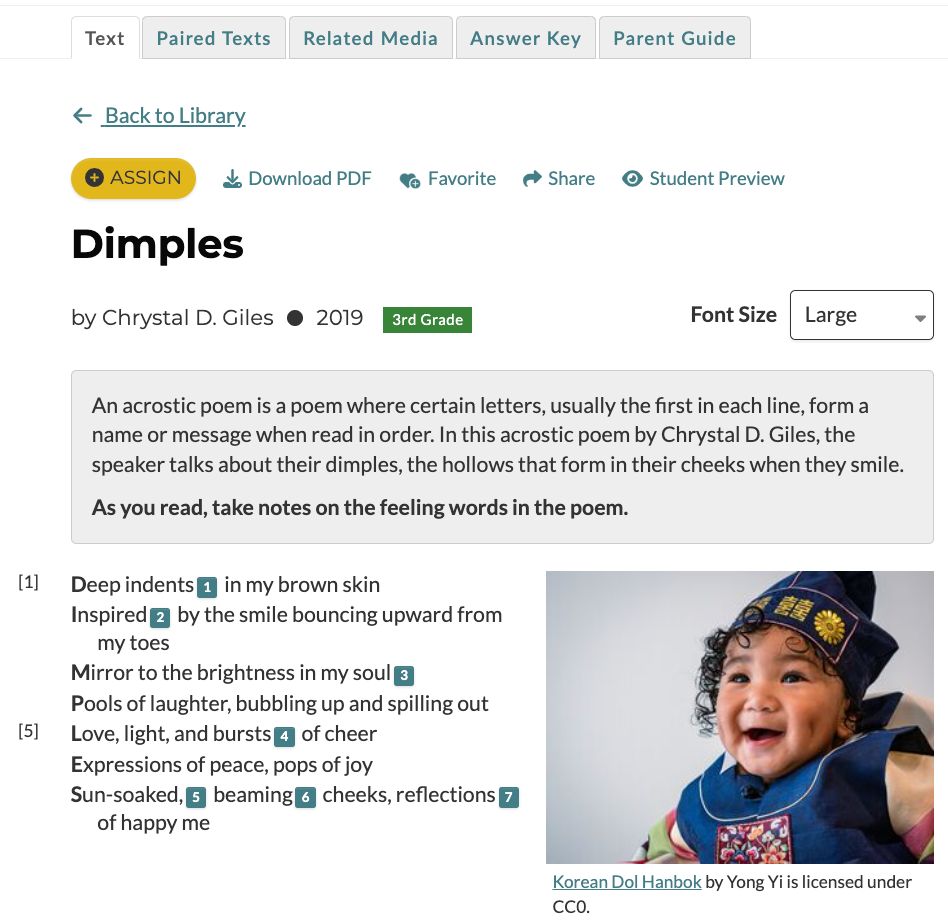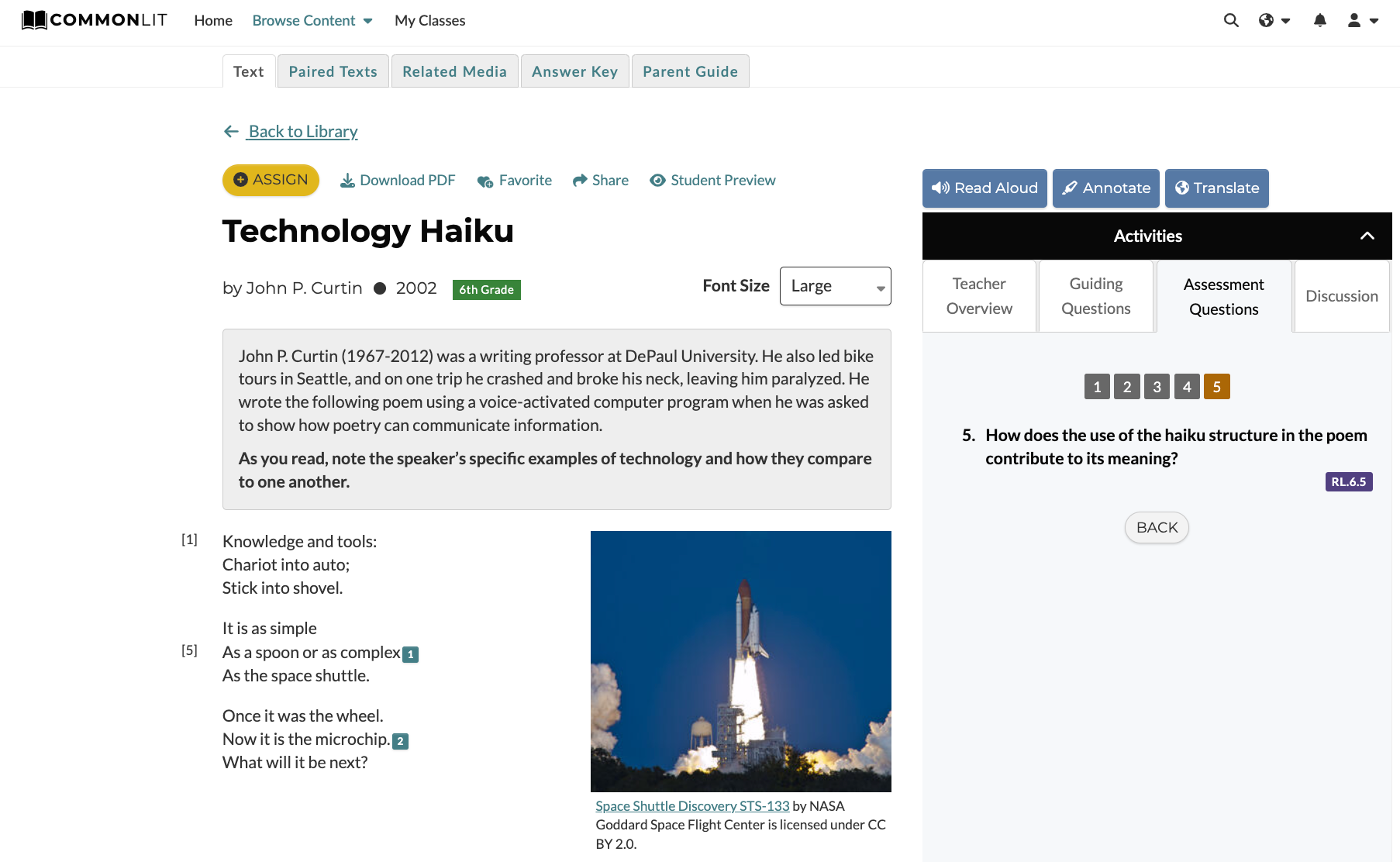 Elementary Classrooms
Secondary Classrooms
8 Poetry Lessons to Help Your Students Become Well Versed in Verse
Elementary Classrooms
Secondary Classrooms
8 Poetry Lessons to Help Your Students Become Well Versed in Verse
This April, celebrate all forms of poetry in your classroom with curated lessons for grades 3-12.
Poetry comes in many shapes and sizes. From Shakespearean sonnets to free verse works by modern poet laureates, students will be engaged in these 8 poetry lessons celebrating different poetic forms.
“Dimples” by Chrystal D. Giles (3rd Grade)
An acrostic poem uses letters to spell out a message when read vertically. In this poem, contemporary poet Chrystal D. Giles writes about their dimples and the joyful feelings they reveal.
Acrostic poems are a great entry point for a unit on poetry, especially with elementary students. Read “Dimples” with your students to give them an example of acrostic poetry. Then, ask students to write their own acrostic poem about something they love about themselves.

“Diary of a Sweatshirt: The Best Day Ever” by Diana Murray (4th Grade)
A mask poem is a style of poetry that uses the first person but is written from the perspective of someone other than the author. In this poem, the speaker is a sweatshirt who describes having a great day playing outside.
In this poetry lesson for elementary students spark a discussion about the speaker of the poem. Ask students Discussion Question 1: “Throughout the poem, the speaker gives the reader clues about their identity. Think about what makes you special. What do you do or say to let others learn more about who you are?”
“On Turning Ten” by Billy Collins (6th Grade)
Free verse is a style of poetry written without a distinct rhyme scheme, syllable count, or structure. Our library includes 55 free verse poems. The selection demonstrates to students the wide range of poetry! Billy Collins, former Poet Laureate of the United States, wrote this poem about the nostalgia a child faces as they venture into adulthood.
Pair this poem with the video “On Turning Ten” from the Related Media Tab. The video pairs the audio of the poem with a soundtrack and imagery. Ask students how the images used in the clip support the poem's themes. Does the music create a mood that lends itself to the theme of the poem? Can the delivery of a poem change the meaning?
“Technology Haiku” by John P. Curtain (6th Grade)
A haiku is a highly structured poem that consists of verses with three lines; the first line has five syllables, the second line has seven syllables, and the last has five syllables. In “Technology Haiku,” Curtain ponders the power of technology and the human urge to create.
After reading, ask students Assessment Question 5: “How does the haiku structure contribute to the poem’s meaning?” Allow this question to prompt a conversation about poetic structure and why an author might choose one form over another.

“Sonnet 18” by William Shakespeare (10th Grade)
A sonnet is a poem that typically consists of 14 lines with a distinct rhyme scheme and syllable count. There are nine sonnets on the CommonLit library. In “Sonnet 18,” the speaker compares his lover to the beauty of the natural world.
Use this poem to prompt a class discussion on the lasting effects of poetry. This poem was written over 500 years ago, why are people still reading it today? Are the themes Shakespeare is writing about still relevant?
“To An Athlete Dying Young” by A. E. Housman (10th Grade)
An elegy is a poem written to honor the dead or something from the past. Our library is home to three elegy poems, including “To An Athlete Dying Young” which is written about the author's friend who passed away.
This poem can be used as the foundation for a lesson about figurative language and rhyme scheme in poetry and how these tools can connote tone. Ask students to use the annotation tool to highlight where figurative language is used to demonstrate the author's feelings. Then, have students use their annotations to answer Assessment Question 5: "Which of the following statements best summarizes what the rhyme scheme contributes to the tone of the poem?"
“To Be Or Not To Be” by William Shakespeare (11th Grade)
Hamlet’s famous dilemma is an example of a soliloquy, a poem in which the speaker narrates their thoughts out loud. In this speech, Hamlet feels utterly alone and questions whether life is worthwhile.
Compare this soliloquy to another soliloquy Hamlet gives earlier in the play, entitled “Frailty, Thy Name is Woman”. Ask students to analyze Hamlet’s perspective in both excerpts. How does each text develop Hamlet’s perspective and help students better understand his character? Does his tone change between the two excerpts?
“Ode on a Distant Prospect of Eton College” by Thomas Gray (12th Grade)
An ode is a poem or song that pays homage to a certain person or thing. Odes are distinctly structured and can be sung as well as read. Our library includes three odes to explore with students. This poem was written to pay tribute to the author's time at Eton College, back when he was young and carefree.
Show students Lauren Carstensen’s TED Talk, “Older people are happier,” from the Related Media Tab. This short video argues that as people get older, they become happier and have a more positive outlook on the world. Ask students to compare the messages of the two pieces. Have students use evidence to explain why they agree with Gray or Carstensen.
Next Steps
Looking for more examples of the many styles of poetry? The CommonLit library has hundreds of poems. Here are some examples of epics, narratives, mirrors, chants, and epistles!
Want to learn more about utilizing CommonLit’s free digital literacy program in your classroom? Join one of our upcoming webinars!

